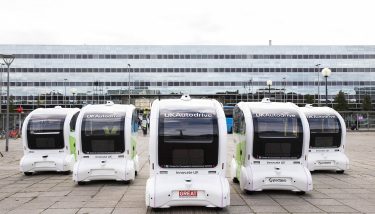“
Coventry-based manufacturer, Aurrigo is playing the largest role in the world’s first ever multi connected and autonomous vehicle demonstration today.

The specialist, which employs 81 people, is using its Pod Zeros to showcase an autonomous first/last mile transport solution in Coventry and Milton Keynes.
It marks the peak of the UK Autodrive project, which was created with the aim of establishing the UK as a global hub for the development of autonomous vehicle technology.
The company has used the programme to develop its autonomous control systems and to refine the design of its pods, creating an advanced production line at its facility in the West Midlands.
It has also sealed two international distribution agreements with partners in Singapore and Vietnam to start selling its vehicles into Asia.

Aurrigo supplied two pods for the first demonstration outside Coventry Transport Museum on Monday, before a number of its pods are set to complete the first ever fully autonomous journey in Milton Keynes today.
The company is projecting a substantial increase in turnover that could run to tens of millions over the next three years.
The Pods can seat up to four people, travel at 15mph and cover up to 60 miles on one charge.
Are AVs trustworthy?
The showcase comes after Aurrigo joined forces with Jaguar Land Rover earlier this year to fit ‘virtual eyes’ to its pods, in an attempt to understand how humans might trust self-driving vehicles.

The aim of the technology is to help work out how much information future self-driving cars should share with users and or pedestrians, to enable people to begin to trust the technology.
The virtual eyes have been devised by a team of advanced engineers, working in JLR’s Future Mobility division. Engineers record trust levels in the person before and after they look at the virtual eyes, to find out whether it generates sufficient confidence that it would stop for them.
As part of the study, more than 500 test subjects have been monitored interacting with the self-driving Aurrigo pods.
The trials are part of a wider study exploring how future connected and autonomous vehicles can replicate human behaviour and reactions when driving.
You may also be interested in reading:
Get insights like this delivered straight to your inbox
Digital briefings | Front-of-mind topics
- Monday: Manufacturing Innovation
- Tuesday: Manufacturing Leadership
- Wednesday: Digital Transformation
- Thursday: Industrial Internet
Sign up for free here.
